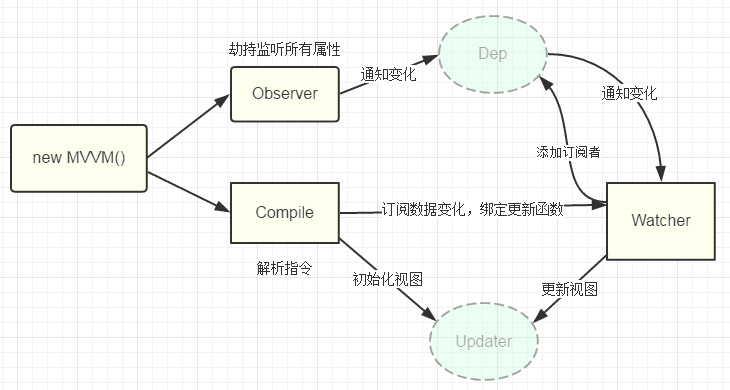您好,登录后才能下订单哦!
小编给大家分享一下vue双向数据绑定知识点有哪些,相信大部分人都还不怎么了解,因此分享这篇文章给大家参考一下,希望大家阅读完这篇文章后大有收获,下面让我们一起去了解一下吧!
1.原理
vue的双向数据绑定的原理相信大家都十分了解;主要是通过ES5的Object对象的defineProperty属性;重写data的set和get函数来实现的
所以接下来不使用ES6进行实际的代码开发;过程中如果函数使用父级this的情况;还是使用显示缓存中间变量和闭包来处理;原因是箭头函数没有独立的执行上下文this;所以箭头函数内部出现this对象会直接访问父级;所以也能看出箭头函数是无法完全替代function的使用场景的;比如我们需要独立的this或者argument的时候
1.2 defineProperty是什么
语法:
Object.defineProperty(obj, prop, descriptor)
参数:
obj:必要的目标对象
prop:必要的需要定义或者修改的属性名
descriptor:必要的目标属性全部拥有的属性
返回值:
返回传入的第一个函数;即第一个参数obj
该方法允许精确的添加或者修改对象的属性;通过赋值来添加的普通属性会创建在属性枚举期间显示(fon...in;object.key);这些添加的值可以被改变也可以删除;也可以给这个属性设置一些特性;比如是否只读不可写;目前提供两种形式:数据描述(set;get;value;writable;enumerable;confingurable)和存取器描述(set;get)
数据描述
当修改或者定义对象的某个属性的时候;给这个属性添加一些特性
var obj = {
name:'xiangha'
}
// 对象已有的属性添加特性描述
Object.defineProperty(obj,'name',{
configurable:true | false, // 如果是false则不可以删除
enumerable:true | false, // 如果为false则在枚举时候会忽略
value:'任意类型的值,默认undefined'
writable:true | false // 如果为false则不可采用数据运算符进行赋值
});
但是存在一个交叉;如果wrirable为true;而configurable为false的时候;所以需要枚举处理enumerable为false
--- 我是一个writable栗子 ---
var obj = {};
Object.defineProperty(obj,'val',{
value:'xiangha',
writable:false, // false
enumerable:true,
configurable:true
});
obj.val = '书记'; // 这个时候是更改不了a的
--- 我是一个configurable栗子 ---
var obj = {};
Object.defineProperty(obj,'val',{
value:'xiangha',
writable:true, // true
enumerable:true,
configurable:false // false
});
obj.val = '书记'; // 这个时候是val发生了改变
delete obj.val 会返回false;并且val没有删除
--- 我是一个enumerable栗子 ---
var obj = {};
Object.defineProperty(obj,'val',{
value:'xiangha',
writable:true,
enumerable:false, // false
configurable:true
});
for(var i in obj){
console.log(obj[i]) // 没有具体值
}
综上:对于我们有影响主要是configurable控制是否可以删除;writable控制是否可以修改赋值;enumerable是否可以枚举所以说一旦使用Object.defineProperty()给对象添加属性;那么如果不设置属性的特性;则默认值都为false
var obj = {};
Object.defineProperty(obj,'name',{}); // 定义了心属性name后;这个属性的特性的值都为false;这就导致name这个是不能重写不能枚举不能再次设置特性的
obj.name = '书记';
console.log(obj.name); // undefined
for(var i in obj){
console.log(obj[i])
}总结特性:
value:设置属性的值
writable ['raɪtəbl] :值是否可以重写
enumerable [ɪ'nju:mərəbəl]:目标属性是否可以被枚举
configurable [kən'fɪgərəbl]:目标属性是否可以被删除是否可以再次修改特性
存取器描述
var obj = {};
Object.defineProperty(obj,'name',{
get:function(){} | undefined,
set:function(){} | undefined,
configuracble:true | false,
enumerable:true | false
})
注意:当前使用了setter和getter方法;不允许使用writable和value两个属性gettet&& setter
当设置获取对象的某个属性的时候;可以提供getter和setter方法
var obj = {};
var value = 'xiangha';
Object.defineProperty(obj,'name',{
get:function(){
// 获取值触发
return value
},
set:function(val){
// 设置值的时候触发;设置的新值通过参数val拿到
value = val;
}
});
console.log(obj.name); // xiangha
obj.name = '书记';
console,.log(obj.name); // 书记get和set不是必须成对出现对;任写一个就行;如果不设置set和get方法;则为undefined
哈哈;前戏终于铺垫完成了
补充:如果使用vue开发项目;尝试去打印data对象的时候;会发现data内的每一个属性都有get和set属性方法;这里说明一下vue和angular的双向数据绑定不同
angular是用脏数据检测;Model发生改变的时候;会检测所有视图是否绑定了相关的数据;再更新视图
vue是使用的发布订阅模式;点对点的绑定数据

2.实现
<div id="app"> <form> <input type="text" v-model="number"> <button type="button" v-click="increment">增加</button> </form> <h4 v-bind="number"></h4> </div>
页面很简单;包含:
一个input,使用v-model指令
一个button,使用v-click指令
一个h4,使用v-bind指令。
我们最后也会类似vue对方式来实现双向数据绑定
var app = new xhVue({
el:'#app',
data: {
number: 0
},
methods: {
increment: function() {
this.number ++;
},
}
})2.1 定义
首先我们需要定义一个xhVue的构造函数
function xhVue(options){
}2.2 添加
为了初始化这个构造函数;给其添加一个_init属性
function xhVue(options){
this._init(options);
}
xhVue.prototype._init = function(options){
this.$options = options; // options为使用时传入的结构体;包括el,data,methods等
this.$el = document.querySelector(options.el); // el就是#app,this.$el是id为app的Element元素
this.$data = options.data; // this.$data = {number:0}
this.$methods = options.methods; // increment
}2.3 改造升级
改造_init函数;并且实现_xhob函数;对data进行处理;重写set和get函数
xhVue.prototype._xhob = function(obj){ // obj = {number:0}
var value;
for(key in obj){
if(obj.hasOwnProperty(ket)){
value = obj[key];
if(typeof value === 'object'){
this._xhob(value);
}
Object.defineProperty(this.$data,key,{
enumerable:true,
configurable:true,
get:function(){
return value;
},
set:function(newVal){
if(value !== newVal){
value = newVal;
}
}
})
}
}
}
xhVue.prototype._init = function(options){
this.$options = options;
this.$el = document.querySelector(options.el);
this.$data = options.data;
this.$method = options.methods;
this._xhob(this.$data);
}2.4 xhWatcher
指令类watcher;用来绑定更新函数;实现对DOM更新
function xhWatcher(name,el,vm,exp,attr){
this.name = name; // 指令名称;对于文本节点;例如text
this.el = el; // 指令对应DOM元素
this.vm = vm; // 指令所属vue实例
this.exp = exp; // 指令对应的值;例如number
this.attr = attr; // 绑定的属性值;例如innerHTML
this.update();
}
xhWatcher.prototype.update = function(){
this.el[this.attr] = this.vm.$data[this.exp];
// 例如h4的innerHTML = this.data.number;当numner改变则会触发本update方法;保证对应的DOM实时更新
}2.5 完善_init和_xhob
继续完善_init和_xhob函数
// 给init的时候增加一个对象来存储model和view的映射关系;也就是我们前面定义的xhWatcher的实例;当model发生变化时;我们会触发其中的指令另其更新;保证了view也同时更新
xhVue.prototype._init = function(options){
this.$options = options;
this.$el = document.querySelector(options.el);
this.$data = options.data;
this.$method = options.methods;
this._binding = {}; // _binding
this._xhob(this.$data);
}
// 通过init出来的_binding
xhVue.prototype._xhob = function(obj){ // obj = {number:0}
var value;
for(key in obj){
if(obj.hasOwnProperty(ket)){
this._binding[key] = {
// _binding = {number:_directives:[]}
_directives = []
}
value = obj[key];
if(typeof value === 'object'){
this._xhob(value);
}
var binding = this._binding[key];
Object.defineProperty(this.$data,key,{
enumerable:true,
configurable:true,
get:function(){
return value;
},
set:function(newVal){
if(value !== newVal){
value = newVal;
// 当number改变时;触发_binding[number]._directives中已绑定的xhWatcher更新
binding._directives.forEach(function(item){
item.update();
});
}
}
})
}
}
}2.6 解析指令
怎么才能将view与model绑定;我们定义一个_xhcomplie函数来解析我们的指令(v-bind;v-model;v-clickde)并这这个过程中对view和model进行绑定
xhVue.prototype._xhcompile = function (root) {
// root是id为app的element的元素;也就是根元素
var _this = this;
var nodes = root.children;
for (var i = 0,len = nodes.length; i < len; i++) {
var node = nodes[i];
if (node.children.length) {
// 所有元素进行处理
this._xhcompile(node)
};
// 如果有v-click属性;我们监听他的click事件;触发increment事件,即number++
if (node.hasAttribute('v-click')) {
node.onclick = (function () {
var attrVal = nodes[i].getAttribute('v-click');
// bind让data的作用域与methods函数的作用域保持一致
return _this.$method[attrVal].bind(_this.$data);
})();
};
// 如果有v-model属性;并且元素是input或者textrea;我们监听他的input事件
if (node.hasAttribute('v-model') && (node.tagName = 'INPUT' || node.tagName == 'TEXTAREA')) {
node.addEventListener('input', (function (key) {
var attrVal = node.getAttribute('v-model');
_this._binding[attrVal]._directives.push(new xhWatcher(
'input',
node,
_this,
attrVal,
'value'
));
return function () {
// 让number的值和node的value保持一致;就实现了双向数据绑定
_this.$data[attrVal] = nodes[key].value
}
})(i));
};
// 如果有v-bind属性;我们要让node的值实时更新为data中number的值
if (node.hasAttribute('v-bind')) {
var attrVal = node.getAttribute('v-bind');
_this._binding[attrVal]._directives.push(new xhWatcher(
'text',
node,
_this,
attrVal,
'innerHTML'
))
}
}
}并且将解析函数也加到_init函数中
xhVue.prototype._init = function(options){
this.$options = options;
this.$el = document.querySelector(options.el);
this.$data = options.data;
this.$method = options.methods;
this._binding = {}; // _binding
this._xhob(this.$data);
this._xhcompile(this.$el);
}最后
<!DOCTYPE html>
<html lang="en">
<head>
<meta charset="UTF-8">
<title>Document</title>
</head>
<body>
<div id="app">
<form>
<input type="text" v-model="number">
<button type="button" v-click="increment">增加</button>
</form>
<h4 v-bind="number"></h4>
</div>
</body>
<script>
function xhVue(options) {
this._init(options);
}
xhVue.prototype._init = function (options) {
this.$options = options;
this.$el = document.querySelector(options.el);
this.$data = options.data;
this.$method = options.methods;
this._binding = {}; // _binding
this._xhob(this.$data);
this._xhcompile(this.$el);
}
xhVue.prototype._xhob = function (obj) {
var value;
for (key in obj) {
if (obj.hasOwnProperty(key)) {
this._binding[key] = {
_directives: []
}
value = obj[key];
if (typeof value === 'object') {
this._xhob(value);
}
var binding = this._binding[key];
Object.defineProperty(this.$data, key, {
enumerable: true,
configurable: true,
get: function () {
console.log(`get${value}`)
return value;
},
set: function (newVal) {
if (value !== newVal) {
value = newVal;
console.log(`set${newVal}`)
// 当number改变时;触发_binding[number]._directives中已绑定的xhWatcher更新
binding._directives.forEach(function (item) {
item.update();
});
}
}
})
}
}
}
xhVue.prototype._xhcompile = function (root) {
// root是id为app的element的元素;也就是根元素
var _this = this;
var nodes = root.children;
for (var i = 0, len = nodes.length; i < len; i++) {
var node = nodes[i];
if (node.children.length) {
// 所有元素进行处理
this._xhcompile(node)
};
// 如果有v-click属性;我们监听他的click事件;触发increment事件,即number++
if (node.hasAttribute('v-click')) {
node.onclick = (function () {
var attrVal = node.getAttribute('v-click');
console.log(attrVal);
// bind让data的作用域与method函数的作用域保持一致
return _this.$method[attrVal].bind(_this.$data);
})();
};
// 如果有v-model属性;并且元素是input或者textrea;我们监听他的input事件
if (node.hasAttribute('v-model') && (node.tagName = 'INPUT' || node.tagName == 'TEXTAREA')) {
node.addEventListener('input', (function (key) {
var attrVal = node.getAttribute('v-model');
_this._binding[attrVal]._directives.push(new xhWatcher(
'input',
node,
_this,
attrVal,
'value'
));
return function () {
// 让number的值和node的value保持一致;就实现了双向数据绑定
_this.$data[attrVal] = nodes[key].value
}
})(i));
};
// 如果有v-bind属性;我们要让node的值实时更新为data中number的值
if (node.hasAttribute('v-bind')) {
var attrVal = node.getAttribute('v-bind');
_this._binding[attrVal]._directives.push(new xhWatcher(
'text',
node,
_this,
attrVal,
'innerHTML'
))
}
}
}
function xhWatcher(name, el, vm, exp, attr) {
this.name = name; // 指令名称;对于文本节点;例如text
this.el = el; // 指令对应DOM元素
this.vm = vm; // 指令所属vue实例
this.exp = exp; // 指令对应的值;例如number
this.attr = attr; // 绑定的属性值;例如innerHTML
this.update();
}
xhWatcher.prototype.update = function () {
this.el[this.attr] = this.vm.$data[this.exp];
// 例如h4的innerHTML = this.data.number;当numner改变则会触发本update方法;保证对应的DOM实时更新
}
var app = new xhVue({
el: '#app',
data: {
number: 0
},
methods: {
increment: function () {
this.number++;
}
}
});
</script>
</html>以上是“vue双向数据绑定知识点有哪些”这篇文章的所有内容,感谢各位的阅读!相信大家都有了一定的了解,希望分享的内容对大家有所帮助,如果还想学习更多知识,欢迎关注亿速云行业资讯频道!
免责声明:本站发布的内容(图片、视频和文字)以原创、转载和分享为主,文章观点不代表本网站立场,如果涉及侵权请联系站长邮箱:is@yisu.com进行举报,并提供相关证据,一经查实,将立刻删除涉嫌侵权内容。